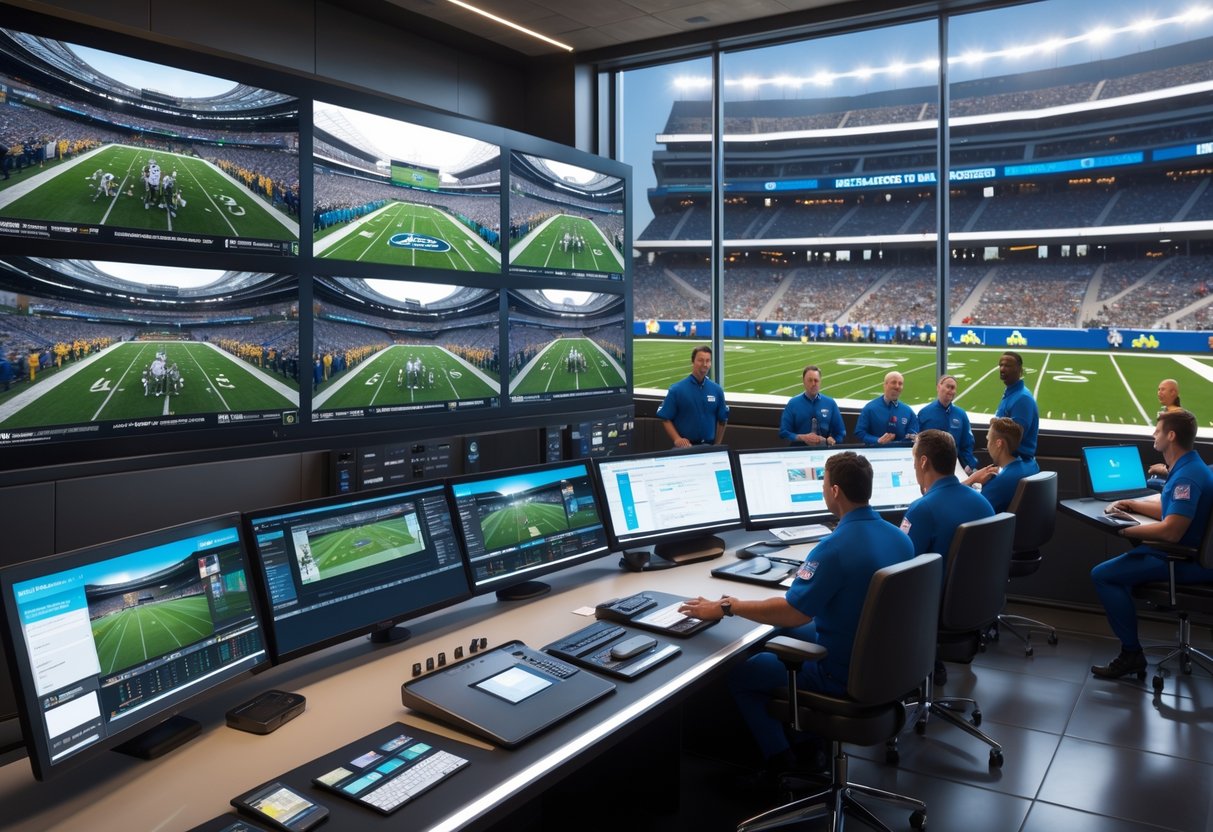Replay System Advances: Next-Gen Technology and Seamless Integration
Updated On: November 13, 2025 by Aaron Connolly
Key Innovations in Replay System Technology
Modern replay systems have come a long way from the old days of basic slow-motion playback. Now, they’re powered by artificial intelligence, multi-angle capture, and open architecture designs.
These advances make highlight creation way faster. They also let productions of any size scale up without breaking the bank. Oh, and they fit right into broadcast workflows without much fuss.
AI-Powered Automation in Replay Systems
Artificial intelligence has totally changed how we create and manage replay content.
AI-powered systems now tag players automatically and generate replays that follow specific athletes all game long.
Automated highlight creation cuts down the operators’ workload. These systems analyze event data and produce clips on their own—no human input needed.
That means broadcasts can turn around highlights much faster than before.
Player tracking technology got a lot smarter. Now, systems can spot individual players and whip up personalized replay packages automatically.
This helps broadcasters tell more engaging stories during live events.
Smart tagging features let operators find big plays in seconds. Instead of digging through hours of footage, AI brings the key moments right to the surface.
So, the whole replay process speeds up.
Software can now create smooth slow-motion effects from regular frame rate cameras. No need for pricey high-speed gear anymore.
Even smaller productions can get pro-level results without the heavy hardware investment.
Multi-Angle and High Frame Rate Capture
Modern replay systems can handle a wild number of camera feeds all at once.
Where productions used to juggle just a handful of angles, now they capture dozens.
High frame rate support is the new normal. Most systems handle 4x or even 6x super-slow-motion cameras.
This gives analysts and fans a closer look at those split-second moments that matter most.
Storage capacity has grown a ton. Replay systems now record every feed continuously, so operators never miss a thing.
No more dropped frames, even during the craziest live events.
Web-based interfaces let operators manage clips from anywhere, even just a laptop.
Whether they’re in a broadcast truck or working remotely, teams can tag content and prep highlights on the fly.
This supports hybrid production workflows and just makes life easier.
Real-time multiviewers show all camera angles with on-screen info.
Operators can keep an eye on everything at once—no more flipping between screens.
That means they can react faster when creating replays during fast-paced events.
Transition to Modular and Open Platforms
The industry has ditched closed, proprietary systems for open, modular solutions.
Modern protocols like AMP and NDI make it way easier to plug different manufacturers’ gear together.
API connectivity lets replay systems and other broadcast tools work together seamlessly.
A single button press can trigger a replay and cue matching graphics at the same time.
Older platforms just couldn’t do this.
Software-defined solutions roll multiple functions into one interface.
Now, one operator can handle switching, replay, and graphics all from the same workstation.
This cuts staffing costs but keeps production quality high.
Scalable deployment options mean you can use the same system for a tiny event or a huge broadcast.
It works solo or with a team, so you get the most from your investment.
Cloud-compatible replay systems take flexibility even further.
You can tap into advanced features as needed—no need to buy extra hardware for those rare big events.
Seamless Integration and Production Workflow Enhancements
Modern replay systems now play nice together thanks to advanced programming interfaces, unified control panels, and cross-manufacturer compatibility.
Broadcast teams can manage multiple systems from just one workstation and cut setup times between events.
API-Driven Workflows
Application Programming Interfaces (APIs) have changed how replay systems connect with other broadcast tech.
APIs let different programs share data automatically, so you don’t have to do it manually.
Sports broadcasters use APIs to link replay systems with graphics, scoreboards, and camera controls.
When a replay operator marks a highlight, the API can trigger on-screen graphics and send clips to social media instantly.
Real-world benefits:
- Automatic highlight reels for post-match content
- Instant data sharing between replay and stats systems
- Remote control for operators working off-site
Most replay manufacturers now offer RESTful APIs that work with standard broadcast protocols.
This lets teams build custom workflows that actually fit their needs—not just whatever the system forces on them.
Unified Control Environments
Broadcast teams want single interfaces that manage multiple replay systems at once.
Dashboard-style controls mean operators don’t have to jump between different brands’ interfaces.
Modern unified systems show all connected replay servers, storage levels, and active recordings on one screen.
Operators trigger replays from any system using the same button layouts and shortcuts.
Key advantages:
- Less training time for new operators
- Fewer slip-ups during live broadcasts
- Consistent workflow, no matter what hardware’s underneath
Some systems now offer touchscreen interfaces that adapt automatically when you plug in new replay gear.
That’s huge for mobile broadcast units, where equipment can change from show to show.
Interoperability Between Manufacturers
Cross-manufacturer compatibility finally solves one of broadcasting’s oldest headaches.
Teams don’t need to stick with one brand just to share replay content or control functions.
Standard protocols like SMPTE ST 2110 let different replay systems exchange high-quality video feeds with no loss.
Broadcasters can mix and match gear based on features, not just brand loyalty.
Integration now supports shared storage systems, so multiple replay servers can access the same content library.
Operators start work on one system, then finish on another—no more manual file transfers.
Remote production workflows really benefit from this.
Production teams can use their favorite replay systems and still plug into any venue’s existing broadcast infrastructure.
Replay Systems in Live Production

Modern live production leans heavily on replay systems to deliver instant access to big moments and boost storytelling with multiple camera angles.
These systems have grown from simple playback tools into platforms that fit right into today’s broadcast workflows.
Instant Replay Access
Replay systems now give operators lightning-fast access to dozens of camera feeds at once.
When covering live events, we need systems that can grab multiple angles without missing a beat and respond instantly when operators trim or cue clips.
Modern systems handle high frame rate capture and everything from SD to 8K feeds.
Operators use intuitive control panels and real-time multiviewers that show all active feeds with on-screen info.
Key performance needs:
- Zero-latency switching between angles
- Continuous recording of every feed
- Instant search and tagging
- Support for super slow-motion cameras
The move to software-defined solutions means operators can work remotely through web interfaces.
Productions can scale up or down—single operator or big team—depending on what the event calls for.
Storage capacity has exploded.
We can now record more channels than ever, all at broadcast quality.
Role in Live Event Storytelling
Replay systems are now at the heart of how we tell stories during live broadcasts.
Instead of just replaying what happened, modern tech helps producers craft compelling narratives with the right angles and perfect timing.
AI-powered features are making highlight creation smarter.
Systems tag players, generate clips from event data, and even create smooth slow-motion from regular frame rate cameras—no need for expensive gear.
Integration with other broadcast tech is key.
Replay systems now link directly with switchers, graphics engines, and media asset management using APIs and protocols like NDI and AMP.
Operators can fire off a replay and cue matching graphics or playlists with just one button.
This tight coordination keeps the show moving and the audience hooked.
Hawk-Eye Innovations and SMART Replay
Hawk-Eye’s Synchronised Multi-Angle Replay Technology (SMART) merges video feeds from multiple broadcast partners into one central hub.
The system uses advanced AI tracking to follow player movements and gives officials instant access to every camera angle.
Synchronised Multi-Angle Technology
The NFL started using Hawk-Eye’s SMART system in 2021 to speed up replay decisions.
Officials now see multiple camera angles of the same play all at once.
The system pulls video feeds from every broadcast partner into one place.
So, referees don’t waste time jumping between sources during critical moments.
Quick win: They already used this tech at Super Bowl LVIII, which over 123 million people watched.
Here’s how SMART works:
- Real-time sync: All camera feeds line up to the same timestamp
- Instant access: Officials switch angles with simple controls
- Remote operation: Operators can work from anywhere
- Cost savings: Less travel for multi-game setups
The SEC uses SMART for football, volleyball, and more.
Officials can review plays independently without waiting on broadcast directors.
AI Cameras and Player Tracking
Hawk-Eye’s system uses AI-powered cameras to track players automatically.
It creates detailed movement data and keeps broadcast replay features intact.
Every Shot Live showed this off at The Players Championship.
Since 2022, the system runs entirely on AWS in the cloud, with four cameras per hole tracking every golfer.
The AI tracking does:
- Automatic following: Cameras track players, no manual work needed
- Data collection: Records movement patterns and positioning
- Graphics integration: Scoring info pops up automatically on broadcasts
- Multi-sport flexibility: Works for all sorts of sports
Heads up: This tech needs a lot of bandwidth and processing power, so it’s pricey for smaller events.
The modular design lets operators customize their workspace for different events.
Engineers can cluster servers for big tournaments and keep backup systems running for reliability.
Advancements in Broadcast Technology
Replay systems now support ultra-high-definition formats and high frame rates.
At the same time, they’re moving toward software-based solutions that replace traditional hardware.
These changes let broadcasters capture more detail and handle complex productions with a lot more flexibility.
Super-Slow-Motion and UHD Inputs
High frame rate (HFR) cameras—running 4x to 6x normal speed—are now a must for modern sports.
They catch moments that regular cameras just miss.
UHD inputs are standard on pro replay systems now.
Broadcasters can record dozens of 4K feeds at once, no dropped frames.
Key capabilities:
- Recording 60+ camera angles in real-time
- Supporting 8K camera feeds for top-tier productions
- Keeping frame-perfect accuracy during playback
- Instant access to any recorded moment
Engineering teams have to process massive amounts of data quickly.
Storage systems need to handle terabytes of footage and still give instant retrieval.
Modern systems got rid of the old analog tape limits.
Now, you can rewind to any frame in seconds, not minutes.
Software-Based Solutions
Software-defined replay systems have replaced dedicated hardware in a lot of control rooms.
One operator can switch, replay, and control graphics from a single interface.
These solutions scale easily.
The same setup that runs a basketball game on Tuesday can handle a football match on Saturday.
Software perks:
- Lower costs: No need for separate replay hardware
- Flexible deployment: Works on-site or in the cloud
- Multi-user support: Several operators share one system
- API integration: Connects with switchers, graphics, and automation
Cloud-based options mean remote production is totally doable.
Operators can manage clips from laptops, whether they’re in a truck or at home.
Heads up: Physical control surfaces still matter for those moments when timing is everything—sometimes a touchscreen just isn’t fast enough.
Replay System Developments in the NFL

The NFL keeps pushing replay technology forward by teaming up with innovative partners and trying new solutions. Hawk-Eye’s SMART system has become the latest leap in multi-angle review, and virtual measurement technology is shaking up those old chain gang routines.
Fixed Boundary Cameras
Back in 2021, the NFL changed the game for replays by rolling out Hawk-Eye’s SMART system in every stadium replay booth. Now, officials can check out several camera angles at once during reviews, not just one feed at a time.
Before this, replay officials had to flip through feeds one by one, which slowed everything down and sometimes left out the crucial shot. The new system really speeds things up.
Hawk-Eye Innovations, famous for their tennis line-calling, brought their multi-camera know-how to American football. The SMART system puts every camera feed together in one easy-to-use interface.
Key advantages include:
- Simultaneous viewing of up to 12 camera angles
- Instant synchronisation across all feeds
- Enhanced zoom for precise reviews
- Review times drop by about 30 seconds
Replay officials in both the stadium and at Art McNally GameDay Central in New York use the system. This setup keeps things consistent and lets officials work together on tough calls.
Virtual Measurements for Officiating
The NFL is testing virtual measurement tech to swap out the old chain gangs. They use advanced tracking data to get exact field positions, so nobody has to drag chains onto the field.
Right now, measuring for first downs means stopping play and stretching out the chains. Sure, it’s classic football drama, but it’s slow and not always spot-on.
Virtual measurements rely on the RFID chips already inside players’ shoulder pads and the football. Stadium receivers pick up the signals, so the system tracks the ball down to the centimetre.
Benefits of virtual measurements:
- No more human error with chain placement
- Instant, precise measurements every time
- Game delays get cut down
- Works in any weather
Still, the NFL faces a bit of a dilemma here. Those chain measurements create suspenseful TV moments fans love. Officials have to walk the line between embracing tech and keeping the traditions that make football so much fun to watch.
Flexible Deployment and Scaling Options

Modern replay systems really flex to fit all sorts of productions and tech setups. They work in the cloud or on-site, scaling from solo operators to big broadcast teams.
Cloud-Based Versus On-Premises
Cloud deployment brings a lot to the table for esports. Remote operators can run clips from their laptops anywhere with Wi-Fi, which is a lifesaver for smaller tournaments looking to cut travel and gear costs.
Cloud systems ramp up fast for big events. When viewership jumps, we just add more processing power—no need to ship extra hardware. Most cloud replay platforms come with backup systems to keep data safe.
On-premises setups still matter for high-stakes productions. Local hardware gives teams complete control over latency and network security. Major esports tournaments often stick with on-site systems to avoid internet hiccups.
The best setups offer hybrid options. Production teams can mix cloud and local resources for each event. A tournament might run live replay on local servers but store highlights in the cloud for sharing.
Solo Operator and Multi-User Setups
Single operator systems work great for smaller esports shows. One person can handle switching, replay, and graphics through all-in-one software. It keeps staffing costs down but still looks pro.
Pre-configured templates cover common esports moments like “Ace” or “Clutch Play.” The operator just picks the right one—no need to build every clip from scratch.
Multi-user environments shine in big productions with tons of camera feeds. Different operators watch over separate game areas or player views at the same time. Everyone works on the same system but sticks to their assigned feeds.
Scalable tech means the same hardware can switch modes. You might run one operator for weekly games, then expand to a full team for championship finals. This flexibility gets the most out of your equipment investment.
Cost-Effectiveness and Operational Simplicity

Modern replay solutions save a ton of money by cutting down on hardware and staff. They offer flexible deployment options that scale from solo setups to complex multi-user environments.
Reducing Hardware and Staffing Needs
Software-based replay systems have changed broadcast operations by rolling multiple jobs into one interface. Operators now manage switching, replay, and graphics from a single workstation.
This setup wipes out the need for separate hardware. Old-school setups needed dedicated replay servers, switching gear, and graphics boxes. Now, software platforms do it all.
- One operator can juggle multiple production tasks
- Lower shipping and setup costs for equipment
- Easier training with simple interfaces
- Licensing models that grow with your needs
Moving away from proprietary systems has made pricing more competitive. Broadcasters aren’t locked into one vendor anymore, which used to drive up costs. Seamless integration between different brands gives buyers more options.
Cloud-compatible solutions cut infrastructure costs even more. Productions get powerful replay features without buying or maintaining expensive hardware. Smaller broadcasters, especially those covering events in different places, really benefit from this.
Efficient Addition of Camera Angles
Modern replay solutions let broadcasters add more camera feeds without making things more complicated or hiring extra staff. High-capacity storage now records dozens of channels at once.
AI tools help operators manage all those feeds. Auto-tagging picks out key moments across every angle, so operators don’t have to watch every feed manually.
Broadcast technology has made multi-angle workflows way smoother:
| Traditional Setup | Modern Systems |
|---|---|
| 1 operator per 4-6 cameras | 1 operator managing 20+ feeds |
| Manual clip creation | AI-assisted highlight generation |
| Fixed hardware capacity | Scalable software solutions |
Template-based setups speed things along. Pre-made replay templates for each sport organize camera feeds by what’s most important. Operators can switch between “touchdown” or “penalty” views in a click.
Web-based interfaces let staff monitor angles remotely. Extra hands can tag or manage clips from their laptops, no need to sit in the main control room. This setup makes everything more efficient and keeps production trucks less crowded.
Challenges in Modern Replay Systems

Replay systems today run into some real technical headaches as they handle more camera feeds and tighter delivery times. The toughest issues usually come down to dealing with massive data streams and working with older broadcast equipment.
Bandwidth and Frequency Management
Modern replay setups have to process tons of high-definition camera feeds at once. Each 4K camera spits out about 12 gigabits of data per second.
Multiply that by 20 or 30 cameras at a typical esports event, and the bandwidth requirements get wild. The system needs to grab it all without dropping frames, even as operators hunt for the best moments in real time.
Storage demands add up fast:
- Standard HD replay: 25 MB per minute per camera
- 4K with high frame rates: 400 MB per minute per camera
- Super slow-motion: Up to 1.2 GB per minute per camera
Network infrastructure often can’t keep up. Old broadcast facilities, built for smaller shows, struggle when esports needs 40+ feeds for player cams, game capture, and crowd shots.
During big moments, things get tricky. When multiple operators pull up the same footage—trimming, making highlights, cueing replays—the system bandwidth really gets stretched.
Legacy Versus Modern Protocols
Lots of broadcast facilities still use protocols from the ’90s. VDCP and AMP systems do the job, but they cause headaches with new replay tech.
We bump into this every day. New replay systems work with APIs and real-time graphics engines, but they also need to talk to switchers and routers that are decades old.
Protocol compatibility issues:
- VDCP limitations: Can’t handle metadata for modern tagging
- GPI triggers: Don’t offer frame-accurate replay control
- Proprietary systems: Lock users in and limit flexibility
Switching to IP-based workflows like NDI and SMPTE ST 2110 helps. Still, upgrading a whole control room costs a fortune.
Smaller esports productions feel stuck in the middle. They want modern replay features but can’t afford to overhaul everything.
Software-defined solutions bridge the gap. They run on standard IT hardware and still talk to old broadcast gear through protocol translation.
Applications Beyond Sport: Training and Analysis

Replay solutions have totally changed the way coaches and analysts work in all sorts of fields. Modern replay systems help coaches break down player performance with detailed video, while officials use them to sharpen their decision-making.
Coaching and Player Improvement
Video delay systems have become must-haves in training, not just live broadcasting. Coaches now give instant feedback during practice.
Athletes can watch their moves just seconds after doing them. This quick replay helps them fix problems before bad habits set in.
Motion capture tech paired with replay systems builds detailed performance profiles. Coaches break down everything from a footballer’s shot to a swimmer’s stroke.
Training facilities often set up multi-angle replay with four to six cameras. This gives coaches every angle they need.
The results are impressive. AI-powered analysis tools track specific movements and flag spots to improve.
Dartfish is a popular choice—73% of Olympic medallists used it during Beijing training camps. Now, even amateur coaches can access this level of analysis.
Officiating Review and Game Preparation
Officials use replay tech to get better at making tough calls. Video analysis helps referees prepare for high-pressure situations.
Training programs now feature tons of video review. Officials study controversial calls and learn from the pros.
Frame-by-frame analysis lets officials see split-second decisions in detail. Real-time viewing just can’t catch everything.
Modern replay systems come with tagging features to sort different decisions. Officials can pull up examples of the exact scenarios they need to practice.
Remote training is a big plus. Officials access video libraries from home, with cloud systems offering thousands of game situations instantly.
Officiating accuracy has noticeably improved where video training is in play. These systems help keep calls consistent across the board.
Market Trends and Future Opportunities

The replay system market is really taking off, with the global sports replay systems market hitting £1.7 billion in 2024 and on track to reach £5.2 billion by 2033. AI-powered tracking tech and new uses across industries are driving most of the change we’re seeing right now.
Expansion of Player and Ball Tracking
Modern replay systems have moved way past simple video capture. Companies like Hawk-Eye Innovations are now blending in machine learning algorithms that track player movements, ball paths, and game events in real time.
This shift is pretty important for competitive gaming. Advanced tracking systems now pick up tiny micro-movements that humans just can’t catch. They break down player positioning, reaction times, and decision-making patterns with millisecond-level accuracy.
Key tracking capabilities include:
- Automated highlight generation
- Performance analytics integration
- Multi-angle synchronisation
- Predictive movement analysis
Costs for these systems have dropped fast. What used to demand £50,000+ installations now runs on regular gaming PCs with special software.
Cloud-based solutions are opening up professional replay analysis to amateur teams and training centres. That’s a game-changer for a lot of folks.
Emerging Standards and Interdisciplinary Use
Replay technology isn’t just sticking to traditional sports anymore. Now, it’s popping up in esports, healthcare simulation, even military training.
We’re starting to see standardised protocols that let different systems share data and work together. That kind of collaboration just wasn’t possible before.
The esports industry gets a big boost from all this crossover. Tournament organisers now use tweaked sports replay systems to capture in-game footage, player reactions, and even audience engagement—all at once.
New application areas include:
- Training simulation review
- Performance coaching tools
- Broadcast enhancement systems
- Fan engagement platforms
Regulatory bodies are rolling out unified standards for replay evidence across different competitive environments. This opens the door for tech providers to build flexible systems that work in multiple industries, not just one sport.
Frequently Asked Questions

Valorant players have wanted replay systems since the game launched. Riot Games has taken its time with the rollout. Knowing when features will arrive, how to use them, and what they actually do can help you get more out of replays.
When can we expect the introduction of a replay system in Valorant?
Riot Games started working on replay systems for Valorant back in 2021. They announced plans for the feature, but haven’t given a solid release date.
The team wants a replay system that doesn’t hurt game performance. Riot always puts stability first, sometimes at the cost of speed.
Right now, it looks like replays might show up in 2025 or 2026. Some players and content creators could get beta access a bit earlier.
How does one utilise the new replay feature in Valorant effectively?
Once the feature is live, you’ll find replays in the match history section. Just click on a finished match to watch the full replay.
Try using the camera controls to swap between player views. It’s a good way to see different angles and decision-making.
Focus on rounds where things went really well—or really badly. Watch enemy movements and spot positioning mistakes.
Jot down notes as you go. If you notice timing problems or bad positioning, write them out so you can fix them later.
Has Valorant included a replay system in its recent update?
Nope, Valorant still doesn’t have a full replay system as of August 2025. Riot is still working on it behind the scenes.
Right now, you only get match history with basic stats. You can check scorelines and see some performance numbers, but you can’t watch the whole match back.
A few third-party tools offer some replay features, but they’re not official and don’t cover everything.
What are the main benefits of using a replay system whilst playing Valorant?
Replay systems let you spot positioning mistakes that you just don’t see while playing live. You can catch patterns in your movement and choices.
It’s way easier to analyse enemy behaviour with replays. Watch how opponents rotate, stack sites, or pull off strategies.
If your team reviews rounds together, you’ll see where communication or timing broke down. That can save rounds in the future.
Content creators get clean replay footage for highlights or guides. Good camera angles make streaming and videos look a lot better.
Could you explain why there was a delay in introducing a replay system to Valorant?
Riot Games puts game stability ahead of new features. They want replays that don’t break servers or cause lag.
Storing all that match data is tough. Every game creates a ton of information, so they need smart compression.
The Vanguard anti-cheat system also makes things more complicated. Riot has to make sure replays don’t open up security risks.
They’ve been focusing resources on balancing gameplay and adding new content. The dev team tackles core issues first, then extra features like replays.
What are the steps to access my previous game’s replay in Valorant?
Right now, you can’t watch full game replays in Valorant. Riot’s still working on the feature, and honestly, nobody knows when it’ll drop.
Once they finally roll out replay systems, you’ll probably find them in the match history tab. I’d expect a “Watch Replay” button to pop up next to your finished matches.
If you want to review your games now, you’ll need to use third-party recording software like OBS. Just set up local recording, and you can watch your own perspective afterward.
Some folks prefer Nvidia ShadowPlay or AMD ReLive for this. These tools automatically save your recent gameplay, making it pretty easy to look back whenever you want.

